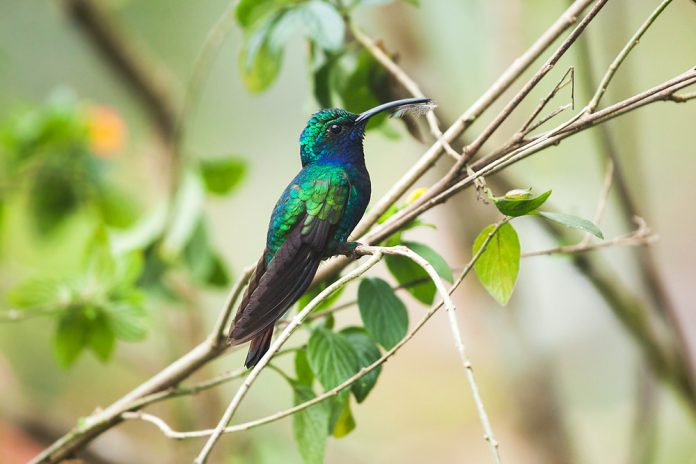Identification: The Lazuline sabrewing (Campylopterus falcatus) male is a large hummingbird that has a shining green back and head, with a shining, dark blue-purple throat and breast, turning to green on the flanks. It has a medium length, slightly down-curved black bill, and small white spots behind each eye. The rounded tail feathers are reddish-brown with dark green tips. The female is similar but is gray-green underneath and has greener on the central tail feathers.
Feed: The Lazuline sabrewing typically feeds at low and mid-levels on the nectar of many plants, flowering ericads, including Heliconia, Hibiscus, and Rubiaceae, and catches insects by hawking and gleaning from foliage. It also revolves around the canopy of flowering trees, i.e., Erythrina.
Nest: This hummingbird constructs a sturdy cup-like nest from plant fibers and moss, in branches overhanging water or the ground.
Status: The current global population has not been measured but is thought to be relatively stable, although the species is considered to be uncommon in Venezuela and Colombia, rare in Ecuador, and patchily distributed. Lazuline Sabrewing is in a large range and doesn’t reach the thresholds for vulnerable, declining, or fluctuating range size, hence it is evaluated as the least concern.
Distribution: This species of hummingbird is in the family of Trochilidae, ranges from north-central Venezuela to northeastern Ecuador, and is also found in Colombia.
Habitat: The Lazuline Sabrewing natural habitats are tropical or subtropical mountainous areas, moist montane forests, forest edges, plantation edges, subparamo, gardens; 1,650–9,850 ft (500–3,000 m)
Size & Length: The average size and length of Lazuline Sabrewing are about 43⁄8–51⁄2 in (11–14 cm).
Weight: The average weight of Lazuline Sabrewing is about 6–9 g
Call/Song/Sounds: The male bird call is chik, chik, chik, splek, seet, tsit, tsuet, with lot of song variations.
Other Names: (Spanish Colibrí Lazulita), (German: Lasurdegenflügel), (French: Campyloptère lazulite), (Italian: Campilottero lazulino), (Dutch: Blauwbuiksabelvleugel), (Russian: Краснохвостый саблекрыл).
Read More – Graceful Honeyeater (Meliphaga gracilis)








